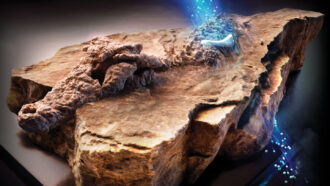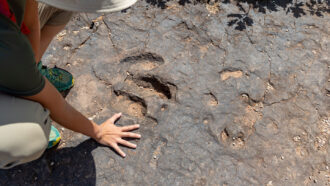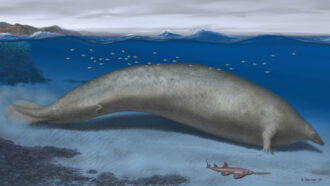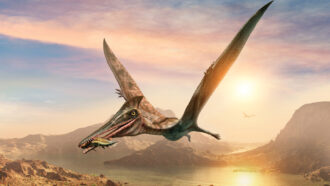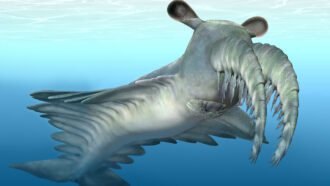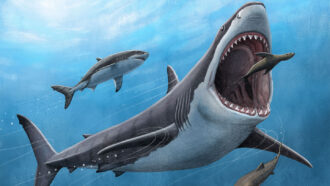Dangerous dinos in the dark
Eye fossils reveal predatory dinosaurs’ preference for hunting at night
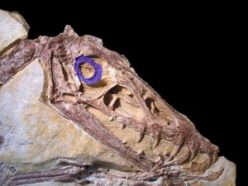
Nighttime is dinnertime for predators around the world. Leopards lurk in the savanna, snakes slither across fields and alligators creep across bayous. These animals are nocturnal, which means they’re active at night. And they’re all hungry.
Millions of years ago, dinosaurs may have had similar habits. In a new study, a pair of biologists from the University of California, Davis studied the fossilized remains of 33 dinosaurs and pterosaurs. (Pterosaurs were flying reptiles, like the pterodactyl, that coexisted with dinos.) The scientists concluded that the animals were active at all hours and that predatory, or meat-eating, dinos preferred to prowl for prey at night.
“We shouldn’t be surprised that there were predatory dinosaurs skulking around the shadows,” Lawrence Witmer told Science News. “The surprising thing about this study is we could tell.” Witmer, who did not work on the new study, is a paleobiologist at Ohio University in Athens. Paleobiologists often study ancient, extinct life to learn more about evolution. Evolution is the process of change in species over long periods of time.
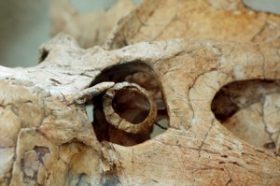
To figure out whether dinos preferred the day or night, the scientists looked at the animals’ eyes. That might seem strange: After all, dinosaur skulls have only holes where the eyes used to be. But the bones around those holes provide clues about the dinosaurs’ lives.
Creatures that are active at night use their eyes in different ways than animals that are mostly active during the day. Depending on what they’re used for, eyes may have different shapes. Modern cats, for example, hunt at night. Their eyes help them do that. A cat eye has a big pupil, which is the black dot at the center that controls how much light gets into the eye. Big pupils let in more light than small ones, so the larger size is helpful for animals hunting in nighttime’s low-light conditions.
Over long periods of time, animals change, or evolve. These changes often help creatures adapt to the world they live in. Predatory dinosaurs that hunt at night may have evolved eyes to help them see. These helpful changes wouldn’t have been only in the eyes. Changes also occurred in the bones that supported the eyes.
The scientists who worked on the dino-eye study first looked at the eyes of modern lizards and birds, which are dinosaurs’ distant relatives. Then the researchers looked at the dinosaur and pterosaur fossils, comparing the bones of those ancient animals to the bones of the modern animals. In particular, the scientists studied the eye socket and the scleral ring. An eye socket is the hole where the eye used to be, and the scleral ring is a small circle of bone that helped support the eye. (Don’t bother looking for your own scleral rings; humans don’t have them.)
The bones around some predatory dinosaurs’ eyes followed similar patterns to those bones found in modern night-hunters, suggesting the dinos also hunted at night. The eyes of the flying pterosaurs suggested these animals flew during the day, like modern birds. And the eyes of big, plant-eating dinosaurs showed some preferred the day, and others preferred the night.
One of the fossils the team studied came from a velociraptor, a ferocious, meat-eating dinosaur that starred in the movie Jurassic Park. In that movie, the predatory dinosaur hunted the main characters at night. The moviemakers may have done their homework.
“The velociraptor was nocturnal in that movie, and it actually fits,” Lars Schmitz told Science News. Schmitz, one of the UC Davis scientists who investigated dinosaur eyes, researches how animal eyes have evolved.
Some people say the eyes are windows to the soul. For dinosaur researchers, the eyes might be windows to the past.
POWER WORDS (adapted from the New Oxford American Dictionary)
extinct No longer existing.
evolution The process of change in species over long periods of time.
nocturnal Done, occurring or active at night.
pterosaur An extinct, warm-blooded flying reptile that lived 245 million years ago to 65 million years ago.
dinosaur A reptile of the Mesozoic era, which lasted from 245 million years ago to 65 million years ago.
scleral ring A circle of bone that helps support the whites of the eyes.


